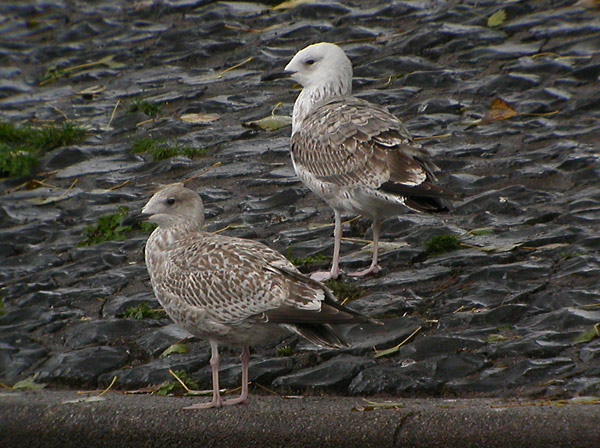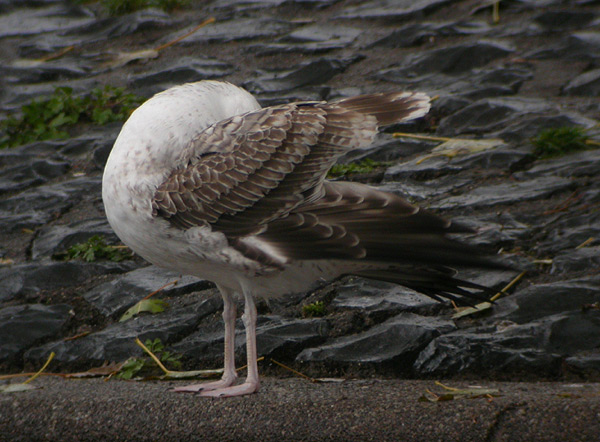| Index > Gulls > Caspian Gulls > | < Pontische Meeuwen < Meeuwen < Index |
1cy Caspian Gull/1kj Pontische Meeuw







1: © Ruud Altenburg, 23-10-04; 2-7: © Ruud Altenburg, 24-10-04. Erasmusgracht, Amsterdam. In every respect a very typical and beautiful 1cy Caspian Gull Larus cachinnans. The head, breast and belly are completely white and give the bird a very different look compared to the average Herring Gull (1, 3, 4). The bill is long and slender, without an obvious gonydial angle. Much of the bill (beyond the nostril) is becoming paler. The legs are thin, pale pink and especially the tibia are longer than those of Herring Gull (4). This bird has replaced most of its scapulars to second generation feathers, which are mostly greyish with a thin dark shaft and a narrow subterminal anchor (compared to the Herring Gulls in 3-4). The tertials have broad, pale tips and lack the notches found in Herring Gull. The coverts are white-edged and show hardly any barring. The median and greater coverts have white tips, which form a double wing bar (1). All coverts still are juvenile. The inner five primaries of the long wing have a pale inner and a dark outer web (6), in a spread wing creating a "Venetian blind", Also note the pale "apical spots" on the outer webs of P2-5. The dark tail bar contrasts with the white upper tail; directly above the band is some barring (7). In alle opzichten een zeer typische en prachtige 1kj Pontische Meeuw Larus cachinnans. De kop, borst en buik zijn helemaal wit en geven de vogel een compleet ander uiterlijk ten opzichte van de gemiddelde Zilvermeeuw (1, 3, 4). De snavel is lang en slank, zonder een opvallende gonyshoek. Een groot gedeelte van de snavel (tot voorbij het neusgat) wordt al lichter. De poten zijn dun, lichtroze, en vooral de tibia zijn langer dan die van Zilvermeeuw (4). Deze vogel heeft de meeste schouderveren vervangen; deze zijn voornamelijk grijzig met een dunne donkere schacht en een smal subterminaal ankertje (vergeleken met de Zilvermeeuwen in 3-4). De tertials hebben een brede lichte top; het gekartelde patroon van Zilvermeeuw ontbreekt. De dekveren hebben een lichte rand en zijn nauwelijks gekarteld. De middelste en grote dekveren hebben lichte toppen die samen een dubbele vleugelstreep vormen (1). Alle dekveren zijn nog juveniel. De binnenste vijf handpennen van de lange vleugel hebben een lichte binnen- en donkere buitenvlag (6), waardoor in een gespreide vleugel een lamelle-achtig patroon ("Venetian blind") ontstaat. Let ook op de lichte vlekken op de donkere buitenvlaggen van P2-5 ("apical spots"). De donkere staartband constrateert met de witte bovenstaart; net boven de band is wat bandering aanwezig (7).
| Back | Terug |